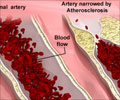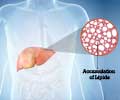
‘The mechanism behind arterial inflammation that leads to atherosclerosis has been identified. Developing drugs to block this pathway may provide prevention from atherosclerosis and heart attack.’
Tweet it Now
"We have known for decades that atherosclerosis is a disease of chronic inflammation that ultimately results in the scarring of arteries and tissue damage," said Moshe Arditi, MD, director of the Infectious and Immunologic Disorders Translational Research Center in the Department of Biomedical Sciences at Cedars-Sinai. "But the ongoing stimulus for this inflammation has been unclear." The study sheds light on this mystery by using a bacterial infection to reveal a cascade of cellular events that can lead to inflammation and atherosclerosis. Arditi is the co-senior author and the lead author of the study, which was led by investigators at Cedars-Sinai.
Investigators focused on interleukin-1 beta, a type of protein that is assembled and released by immune system cells in response to infection and injury, including tissue damage caused by atherosclerosis. While interleukin-1 beta helps rally the immune system against these threats, it also can cause chronic inflammation. The study team wanted to understand how the interleukin-1 beta pathway might promote atherosclerosis.
Using laboratory mice bearing a bacterial infection, along with human cells cultured in a petri dish, the team discovered that several harmful processes related to interleukin-1 beta can lead to buildup of cholesterol in the arteries:
- To make its way out of the immune system cell, interleukin-1 beta can also use the same chemical channels that are used by cholesterol to exit the cell. The result is a "traffic rush" on those channels that blocks the exit of artery-damaging cholesterol and causes it to accumulate in the cell.
- Once it is released by the cell into the body, interleukin-1 beta suppresses a chemical receptor that enables niacin, or Vitamin B3, to be used in the body. This action is harmful because niacin works by removing cholesterol from cells in the artery walls. When niacin is blocked, cholesterol can accumulate in the walls.
- The suppression of the niacin receptor has another negative effect: It reduces the number of chemical channels that cholesterol uses to exit the immune system cell, causing more cholesterol to be trapped inside. That is because the niacin receptor, besides enabling niacin, also increases these channels as part of its normal function.
The Cedars-Sinai study raises the possibility that by using drugs to block the initial production of interleukin-1 beta, rather than just neutralizing it, a stronger positive effect could be obtained for these patients, said Arditi, professor of Pediatrics and Biomedical Sciences.
Advertisement
In addition, Shah, a professor of Medicine who was not involved in the Cedars-Sinai study, said, "A very intriguing aspect of these findings is that they could prompt a re-examination of niacin therapy for atherosclerosis and heart disease." He explained that physicians long used niacin to treat atherosclerosis until the 1980s, when statin drugs were shown to be more effective at reducing cholesterol and cardiovascular risk.
Advertisement
The complete study is published in the journal Cell Metabolism.
Source-Eurekalert













